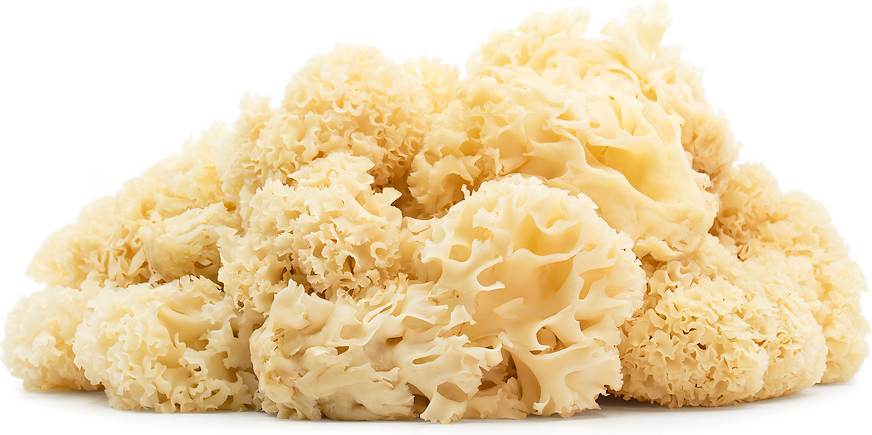


Cauliflower Mushrooms
Estimated Inventory, lb : 8.50
This item was last sold on : 03/29/25
Description/Taste
Cauliflower mushrooms are cap-less fungi composed of clusters of frilled, leaf-like branches emerging from a joined base. The mushrooms widely vary in size, averaging 10 to 30 centimeters in diameter, and can be found in many different contorted shapes. The folded, flexible surface ranges in color from ivory, pale yellow, to white, depending on maturity and is smooth and waxy with small pores on one side that release spores. Cauliflower mushrooms have a brittle, semi-firm, and chewy consistency with a strong aroma of musk and earth. When cooked, they have a neutral, earthy, and subtly nutty flavor with notes of fennel and almond.
Seasons/Availability
Cauliflower mushrooms are available in the fall through early spring.
Current Facts
Cauliflower mushrooms, botanically a part of the Sparassis genus, are ribbon-like fungi belonging to the Sparassidaceae family. There are seven main species found around the world that are generally labeled as Cauliflower mushrooms, with Sparassis crispa and Sparassis radicata being the most common. Cauliflower mushrooms are also known as Noodle mushrooms, Wood cauliflower, and Rooting cauliflower mushrooms. In the wild, Cauliflower mushrooms absorb nutrients from decaying trees and roots and are typically found under conifers and hardwood trees. The fungi are easily identifiable with their large size and dense, noodle-like folds, but despite their distinguishable features, the mushrooms are considered to be somewhat rare due to their solitary nature. In addition to their rarity, knowledgeable foragers often keep the location of wild Cauliflower mushrooms hidden, as the fungus will return to the same spot year after year if harvested correctly. Cauliflower mushrooms are also commercially cultivated and are a specialty variety, favored for use in soups, stews, and stir-fries.
Nutritional Value
Cauliflower mushrooms contain sparassol, which is a nutrient that is known to have anti-fungal and antibiotic properties. The mushrooms also contain beta-glucans, which are a type of dietary fiber that is believed to help boost immunity, heart health, and reduce cholesterol.
Applications
Cauliflower mushrooms are best suited for cooked applications such as boiling and sautéing. It is important to note that the mushroom should be well-cleaned and inspected before eating, as debris and dirt are often found within the dense folds. The mushrooms can be cleaned by cutting the heads into small florets and swishing in a bowl of cold water. Once cleaned, Cauliflower mushrooms can be incorporated into many different soup bases, including chicken, beef, venison, or duck broth, mixed into rice dishes, or stirred into pasta as a noodle substitute. They can also be dredged in tempura batter and fried, slow-cooked into pot roast, or served over toast. Cauliflower mushrooms pair well with rice, asparagus, eggplant, fresh sorrel, carrots, celery, herbs such as parsley, thyme, and basil, oyster sauce, soy sauce, aromatics such as garlic, yellow onions, and ginger, meats such as beef, poultry, and fish, shellfish, and potatoes. The mushrooms will keep up to one week when stored in damp paper towels and kept in a container in the refrigerator.
Ethnic/Cultural Info
In Japan, Cauliflower mushrooms are known as Hanabiratake and have been utilized for both edible and medicinal purposes. The soft, chewy mushrooms are commonly used as a noodle substitute in soups and are incorporated into stir-fries at teppanyaki-style restaurants. The name teppanyaki is derived from the way the meal is cooked with “teppan” translating to mean “iron plate” and “yaki,” meaning grilled or pan-fried. The multi-course meal is cooked over small, flat grills and is a popular dining-style in Japan, meant to stimulate the senses as a form of entertainment. In teppanyaki-style dishes, Cauliflower mushrooms are favored for their fluid lines, mild flavor, and tender, crisp consistency, often paired with fresh seafood such as prawns.
Geography/History
Cauliflower mushrooms have been growing wild since ancient times and are found around the world in forests of North America, Asia, and Europe. The fungi are typically challenging to forage due to their scarcity and are considered to be a rare delicacy. Cauliflower mushrooms have also been commercially cultivated in Japan, Korea, Australia, and the United States since the late 20th century, sold for export and marketed locally at farmers markets and specialty grocers.
Featured Restaurants
Restaurants currently purchasing this product as an ingredient for their menu.
| Top of the Market | San Diego CA | 619-234-4867 |
| La Costa Resort & Spa Main Kitchen | Carlsbad CA | 760-930-7063 |
| Marriott Marina Kitchen | San Diego CA | 619-234-1500 |
| Rancho Bernardo Inn (Avant) | San Diego CA | 858-675-8505 |
| Georges at the Cove | San Diego CA | 858-454-4244 |
| US Grant Hotel Grill | San Diego CA | 619-232-3121 |
| InterContinental Vistal Kitchen | San Diego CA | 619-501-9400 |
Recipe Ideas
Recipes that include Cauliflower Mushrooms. One
Podcast

















